It would be easy to underestimate Valeriy Zaluzhny. When not in uniform, the general prefers T-shirts and shorts that match his easygoing sense of humor. When he first heard from aides to Ukrainian President Volodymyr Zelensky in late July 2021 that he was being tapped to lead the country’s armed forces, his stunned response was, “What do you mean?” As it sank in that he would become commander in chief, he tells TIME in his first interview since the Russian invasion began, he felt as if he had been punched “not just below the belt but straight into a knockout.” George Patton or Douglas MacArthur he is not.
Yet when the history of the war in Ukraine is written, Zaluzhny is likely to occupy a prominent role. He was part of the Ukrainian brass who spent years transforming the country’s military from a clunky Soviet model into a modern fighting force. Hardened by years of battling Russia on the eastern front, he was among a new generation of Ukrainian leaders who learned to be flexible and delegate decisions to commanders on the ground. His dogged preparation in the run-up to the invasion and savvy battlefield tactics in the early phases of the war helped the nation fend off the Russian onslaught. “Zaluzhny has emerged as the military mind his country needed,” U.S. General Mark Milley wrote for TIME of his counterpart last May. “His leadership enabled the Ukrainian armed forces to adapt quickly with battlefield initiative against the Russians.”
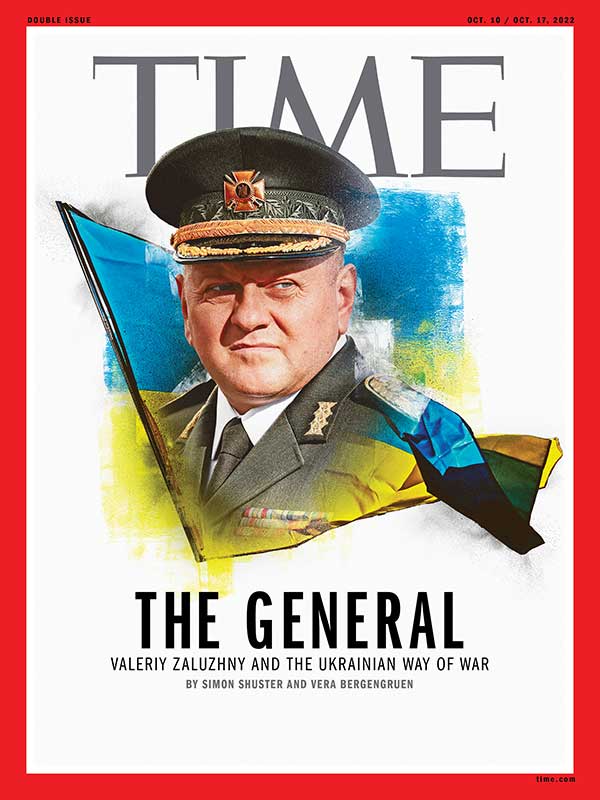
That initiative has now taken a key turn in Ukraine’s favor. In Kyiv’s biggest gains since the war began in February, a lightning counteroffensive in the country’s northeast in early September stunned Russian troops, who fled in disarray and ceded vast swaths of occupied territory. Combined with a second operation in the south, Ukrainian forces say they wrested back more than 6,000 sq km from Russian control in less than two weeks, liberating dozens of towns and cities and cutting off enemy supply lines. The Ukrainian army’s deft game of misdirection, touting a counter-offensive in the south before attacking in the northeast, caught Russia off guard. And it validated the Ukrainians’ arguments that intelligence collaboration and billions of dollars in weapons and materiel supplied by Western allies would yield results on the battlefield.
The sudden victories came at a critical point in what had become a grinding war of attrition. As the economic pressures built across Europe and around the world, skeptics were beginning to doubt whether Ukraine could endure a protracted fight. The dramatic rout rattled Moscow, forcing Kremlin propagandists to admit the setback and upping the military and political pressures on Russian President Vladimir Putin. On Sept. 21 he responded by announcing the first mass conscription since World War II, a partial mobilization of up to 300,000 citizens.
Ukrainian and U.S. officials alike believe the war will be longer and bloodier than most imagine. Putin has shown he’s willing to sacrifice his troops and commit atrocities to exhaust his adversary. In a menacing speech, he warned that he was “not bluffing” when he threatened to use everything at his disposal to defend Russia—an allusion to nuclear weapons. The recent Ukrainian offensive may be a turning point, but it is not the decisive blow. “In hindsight, we’ll look at this like the Battle of Midway,” says Dan Rice, a U.S. Army combat veteran and leadership executive at West Point who serves as a special adviser to Zaluzhny, referring to the pivotal 1942 clash that preceded three more years of war.
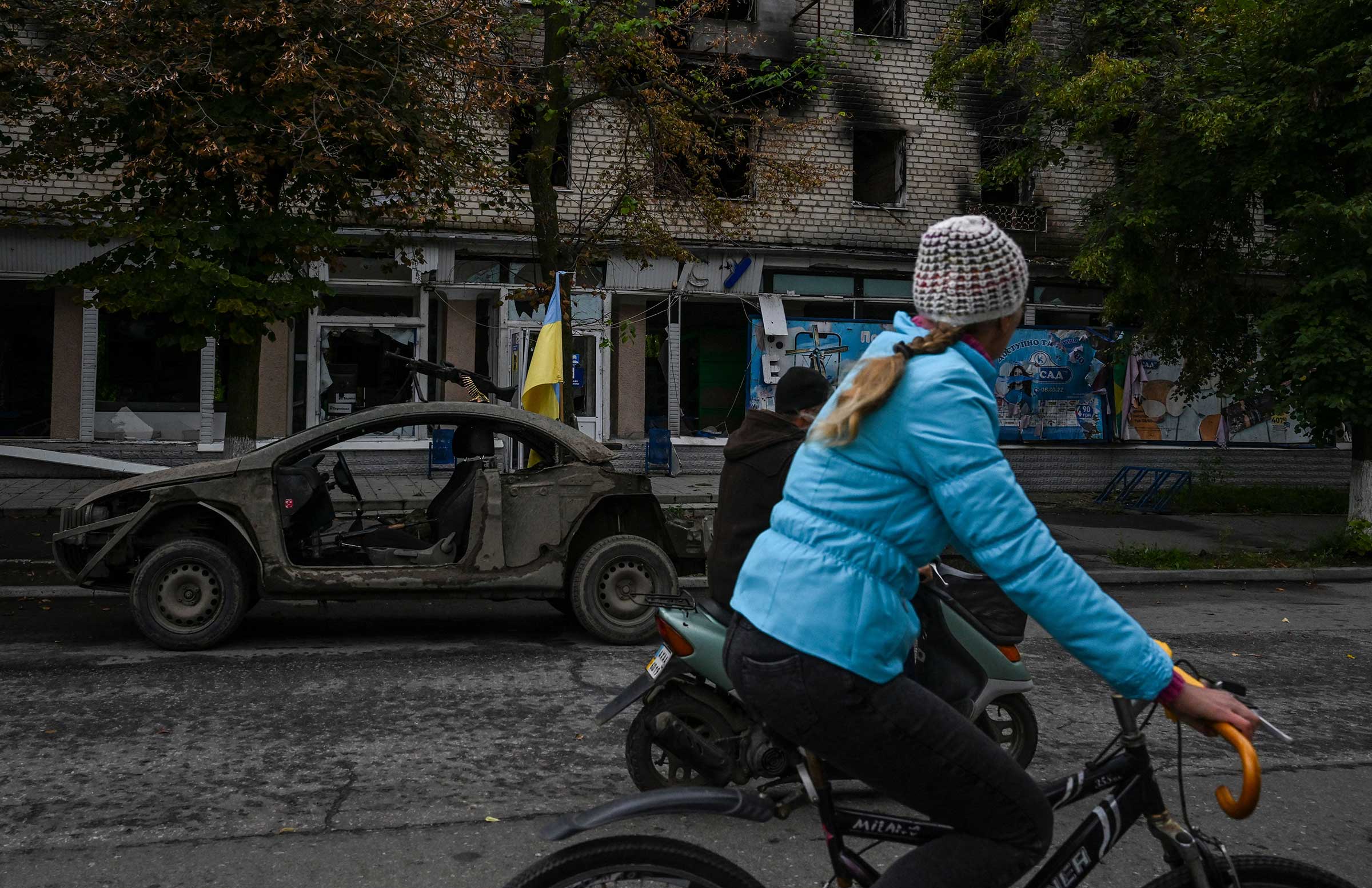
Zaluzhny is just one of many Ukrainians responsible for the grit and progress of the nation’s outmanned army. Other key officers include General Oleksandr Syrskyi, the commander of Ukraine’s ground forces, who led the defense of Kyiv and, more recently, the counteroffensive in the east, and Kyrylo Budanov, the head of Ukraine’s military intelligence service. But after the President, Zaluzhny has become the face of the war effort. His persona is omnipresent on Ukrainian social media. One widely shared image shows the “Iron General” kneeling in front of the sobbing mother of one of his soldiers, head bowed in grief in front of a casket. In another he flashes a grin presiding over the wedding of one of his servicemen during a lull in the fighting. Fan channels on Telegram have hundreds of thousands of followers, with many changing their profiles to a photo of the general with his hands held in the shape of a heart. “When Zaluzhny walks into a dark room he does not turn on the light, he turns off the darkness,” one viral TikTok video jokes.
It’s hard to predict where the war is headed or the part Zaluzhny will play in the end. But perhaps for the first time, it now seems possible that the army he commands could achieve victory.
Zaluzhny was drinking a beer at his wife’s birthday party when he stepped outside to take a cell-phone call and learned about his new job. The 48-year-old general’s rank and stature at the time were far below the position Zelensky was offering him. Commander in chief of the armed forces of Ukraine is the nation’s top military title, outranked only by the President himself. The height of that perch induced a feeling like vertigo. “I’ve often looked back and asked myself: How did I get myself into this?” Zaluzhny told TIME in a June interview.
To some, the choice seemed rash. While he had earned a reputation as an aggressive and ambitious commander, Zaluzhny was also considered a bit of a goofball, better known for clowning around with his troops than disciplining them. Born on a Soviet military garrison in northern Ukraine in 1973, he says he had dreams of becoming a comedian, much like Zelensky himself. Instead, he followed in the footsteps of his military family, entering the academy in Odessa in the 1990s as the Soviet Union collapsed and Ukraine descended into crisis.
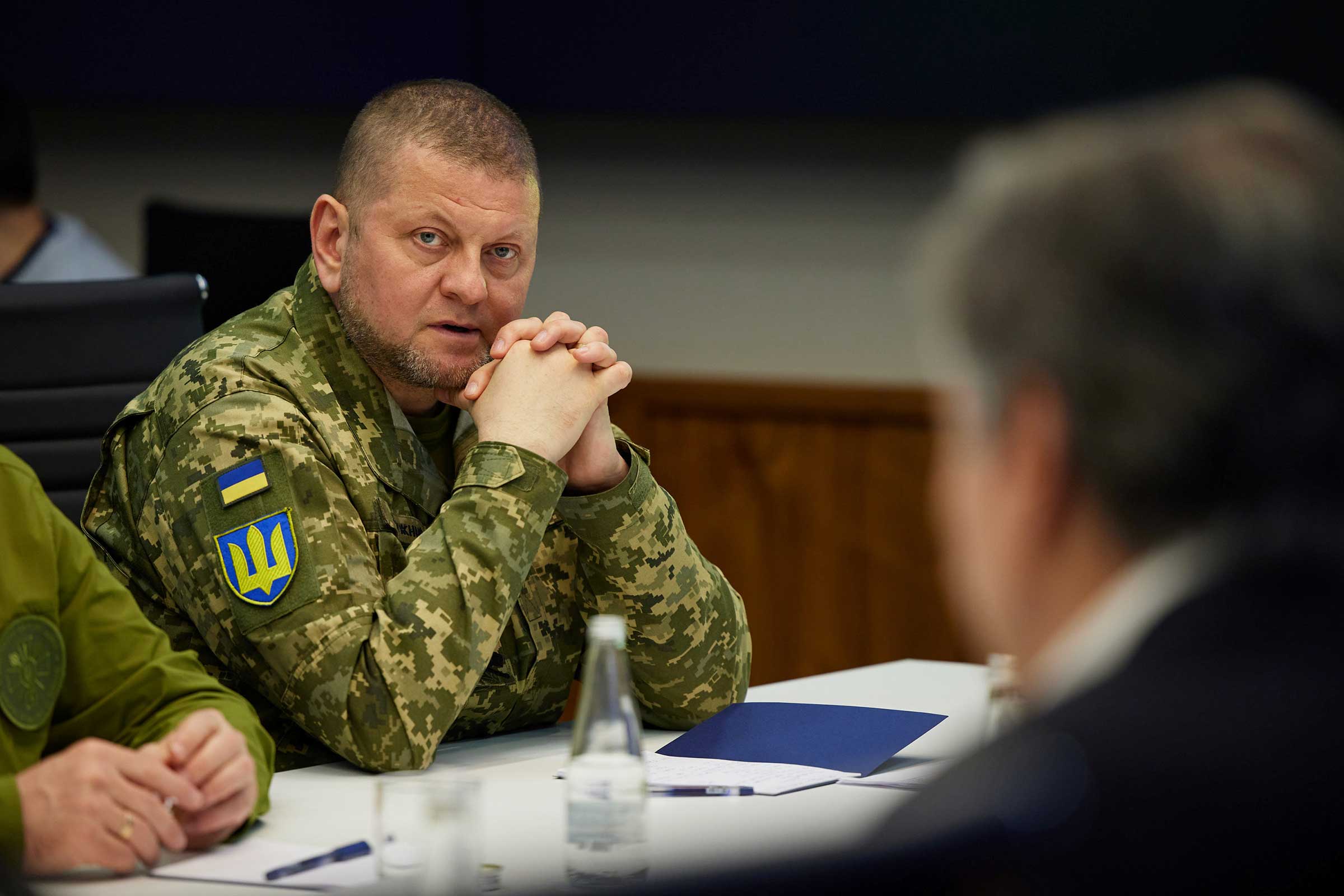
Zaluzhny rose through the ranks with a new generation of officers that bridged very different eras: raised in Soviet Ukraine, but eager to shed USSR military dogma. For a master’s thesis, Zaluzhny analyzed U.S. military structure. Seeing how Ukrainian forces were still weighed down by the Soviet model that relied on rigid, top-heavy decision-making, he began to implement changes to mirror the forces of U.S. and NATO partners.
Zaluzhny worked his way from commanding a platoon to leading the country’s forces on the eastern front following Russia’s annexation of Crimea in 2014. In that role, he developed junior officers and encouraged more agile decision-making, pushing down authority to commanders on the ground. Unlike in the Russian army, sergeants would not be “scapegoats,” but rather real deputies meant to create a pipeline of military talent, he said in a 2020 interview published by the Ukrainian Defense Ministry. “There is no going back,” he said, to “the army of 2013.”
But Zaluzhny also respected and admired the institutions of his Russian counterparts. In his office, he keeps the collected works of General Valery Gerasimov, the head of the Russian armed forces, who is 17 years his senior. “I was raised on Russian military doctrine, and I still think that the science of war is all located in Russia,” Zaluzhny says. “I learned from Gerasimov. I read everything he ever wrote … He is the smartest of men, and my expectations of him were enormous.”

When Zelensky took office in 2019, the war in eastern Ukraine was already in its fifth year, and Zaluzhny was acting commander in the war zone. It fell to him to brief the new President on military operations and command structures. He knew Zelensky had never served in the military, and had no plans to school him in the tactical details of warfare. “He doesn’t need to understand military affairs any more than he needs to know about medicine or bridge building,” Zaluzhny says. To his surprise, Zelensky seemed to agree. “This has turned out to be one of [Zelensky’s] strongest features,” says Oleksiy Melnyk, a former Ukrainian Assistant Defense Minister. He has allowed his generals to run the show “without direct interference into military business.”
In 2020, Zaluzhny oversaw an ambitious set of military exercises, which included a test of the Javelin anti-tank missile. With the President watching from the observation deck, the demonstration failed, and pundits went on Ukrainian TV to debate the bad omen for the nation’s military. Zaluzhny was sure he would be known in the President’s office as “the loser with the faulty Javelins.”
Yet Zelensky has shown a determination to jettison an older generation of officials in search of new blood, and a habit of elevating leaders with whom he feels a rapport, regardless of rank. In July 2021, with the Russians hauling tanks to the border and the Americans warning that Ukraine could soon face a full-scale attack, the President decided to put Zaluzhny in charge. “I gave my opinion that he strikes me as a fairly professional, smart person,” says Andriy Yermak, Zelensky’s chief of staff. “But the President made the call.”
Unlike Zelensky, who was skeptical of intelligence reports that a mass-scale Russian invasion was imminent, Zaluzhny was part of a corps of Ukrainian officers who viewed it as a matter of time. Within weeks of taking up his post, he began to implement key changes. Officers would be free to return fire “with any available weapons” if they came under attack, with no need for permission from senior commanders. “We needed to knock down their desire to attack,” Zaluzhny says. “We also needed to show our teeth.”

By early February, the pressure of his new role was starting to show. The launch of an ambitious set of military exercises involving thousands of Ukrainian troops had been a disappointment, with basic maneuvers meant to simulate a Russian attack exposing cracks in Ukraine’s defenses. In Zaluzhny’s view, the drills were a centerpiece of Ukraine’s defensive strategy, its best chance of survival, and the commanders were not taking them seriously enough. “I spent an hour yelling,” he recalls. “I lost it.” The men seated around the table were mostly older and more experienced than Zaluzhny, who did not have a reputation for losing his cool. “I explained to them that if they can’t pull this off, the consequences will not only cost us our lives, but also our country.”
After the outburst, the generals picked up their preparations. They relocated and camouflaged military hardware, moving troops and weapons out of their bases and sending them on tours around the country. This included aircraft, tanks, and armored vehicles, as well as the antiaircraft batteries Ukraine would soon need to maintain control of its skies. “There’s no mistaking the smell of war,” Zaluzhny says, “and it was already in the air.” But when it came to the details of his strategy, Zaluzhny held them close. “I was afraid that we would lose the element of surprise,” he says. “We needed the adversary to think that we are all deployed in our usual bases, smoking grass, watching TV, and posting on Facebook.”
When the invasion started on the morning of Feb. 24, the general had two strategic goals for Ukraine’s defense. “We could not allow Kyiv to fall,” he said. “And, on all the other vectors, we had to spill their blood, even if in some places it would require losing territory.” The aim, in other words, was to allow the Russians to advance and then destroy their columns in the front and supply lines in the rear. By the sixth day of the invasion, he concluded it was working. The Russians had failed to take airports around Kyiv and had advanced deep enough to begin straining supply lines, leaving them exposed.
Milley, Zaluzhny’s U.S. counterpart, was in some ways astounded when he saw the Ukrainians holding out. He asked Zaluzhny whether he planned to evacuate to safer ground. “I told him, ‘I don’t understand you,’” Zaluzhny says. “For me the war started in 2014 … I didn’t run away then, and I’m not going to run now.”
He too was surprised by Russia’s blunders. When the enemy faced heavy resistance or lost the ability to resupply, they did not retreat or shift to a different approach. “They just herded their soldiers into the slaughter,” Zaluzhny said. “They chose the scenario that suited me best of all.”
Even as the U.S. and allies continued to flood the country with billions in military aid, the news was grim. Russia pounded the strategic port city of Mariupol, killing thousands of civilians. In May, hundreds of Ukrainian fighters who had defended the last stronghold in the city, the Azovstal steel plant, surrendered. (More than 150 were returned Sept. 21 in a prisoner swap, including five top Ukrainian commanders.) Mass graves were discovered in towns and villages occupied by Russian troops. Still, Ukrainian officials insisted they could win. “We will fight until the last drop of blood,” Zaluzhny told TIME.
A few weeks later, Ukraine began to do something that struck military analysts as unusual. From the top of the government, Ukrainian officials, including Zelensky and Defense Minister Oleksiy Reznikov, began to publicly tout their preparations for a large-scale operation to retake territory in the south. In anticipation of an attack, Russia began to reposition troops, including some of its most elite units from other regions to reinforce its positions in the south. On Aug. 29, the Ukrainian military announced that the long-anticipated southern offensive had begun.
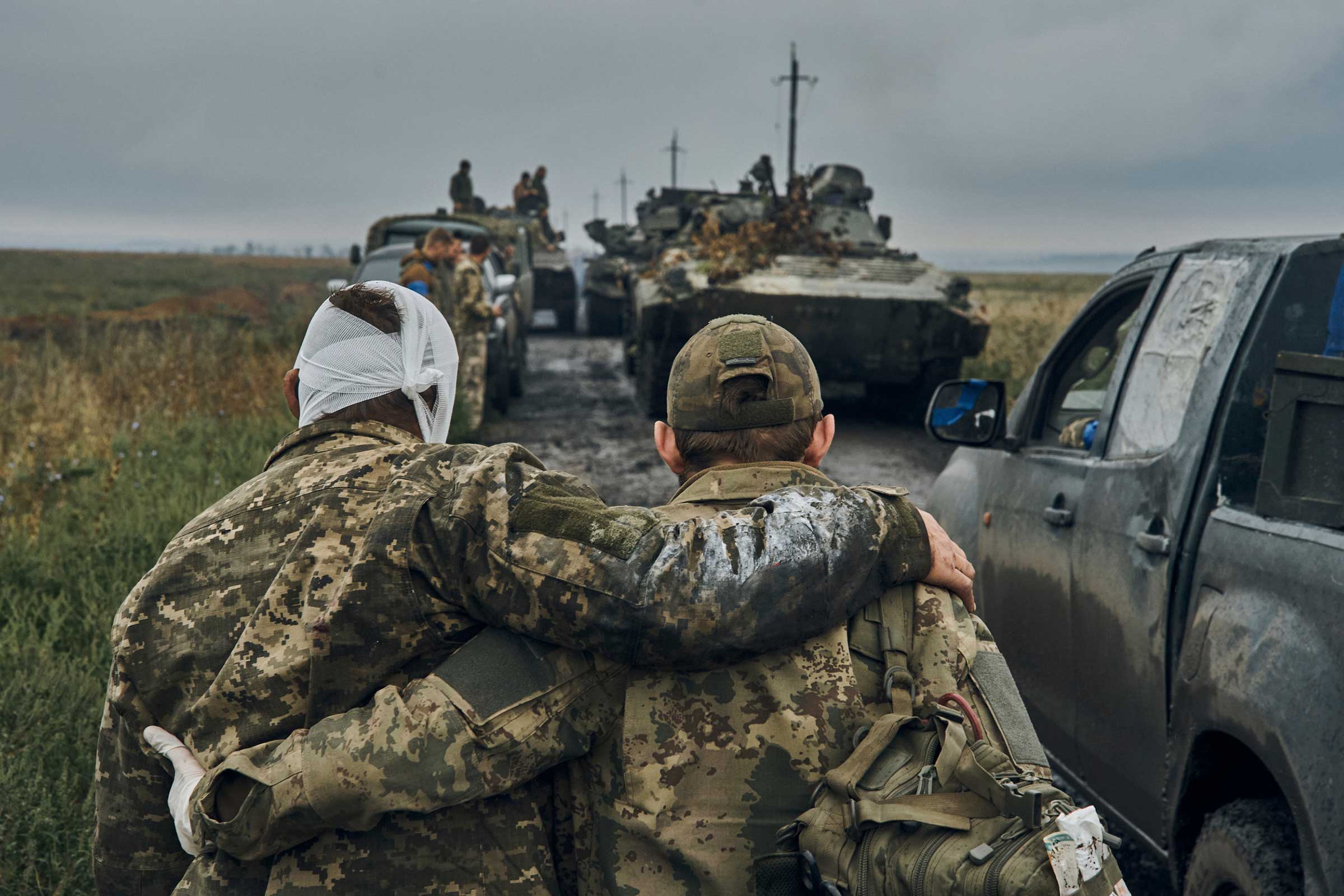
But there were indications something else was afoot. “We have a war on, not only in the south,” Oleksiy Danilov, the head of Ukraine’s National Security and Defense Council, told TIME on Sept. 1. “The front line is 2,500 km long.” Many experts doubted that Ukraine would be capable of mounting a counter-offensive on one front, let alone two.
Five days later, Ukrainian troops launched a surprise strike in the country’s northeast. The Russians were caught off guard. Many fled in disarray, leaving behind weapons and equipment. Local reports painted a humiliating picture of retreat, describing soldiers stealing civilians’ clothes, bicycles, and cars to escape.
In six days, the Ukrainian military retook an estimated 3,000 sq km of Russian-held territory, including strategically important rail hubs used to resupply its forces. The strike stunned the Kremlin, U.S. officials, and even top Ukrainians. “I taught myself to moderate my expectations, so as not to be disappointed later,” Reznikov tells TIME. “Some breakthroughs occurred a little faster than planned.”
Intelligence and advanced weaponry provided by the West also helped. “They gave us the location of the enemy, how many of them are at that location, and what they have stored there,” Reznikov says. “Then we would strike.” The High Mobility Artillery Rocket System (HIMARS) provided by the Pentagon allowed Ukraine to destroy warehouses of ammunition, fuel, and command posts. Lighter vehicles like U.S.-donated humvees, as well as trucks and tanks sent by the U.K., Australia, the Netherlands, Poland, and the Czech Republic, allowed them to outmaneuver the Russians. “Ukrainians have demonstrated much better distributed tactical-level operations,” says Jeffrey Edmonds, a former CIA analyst and Russia director on the National Security Council. “They’re much more disciplined.”
Also crucial, Ukrainian officials say, was the flexible command structure that allowed them to exploit the quick Russian collapse. “The Ukrainian army has the freedom to make decisions at every level,” Reznikov says, likening it to NATO standards. “They do it quickly, unlike the Russians.”
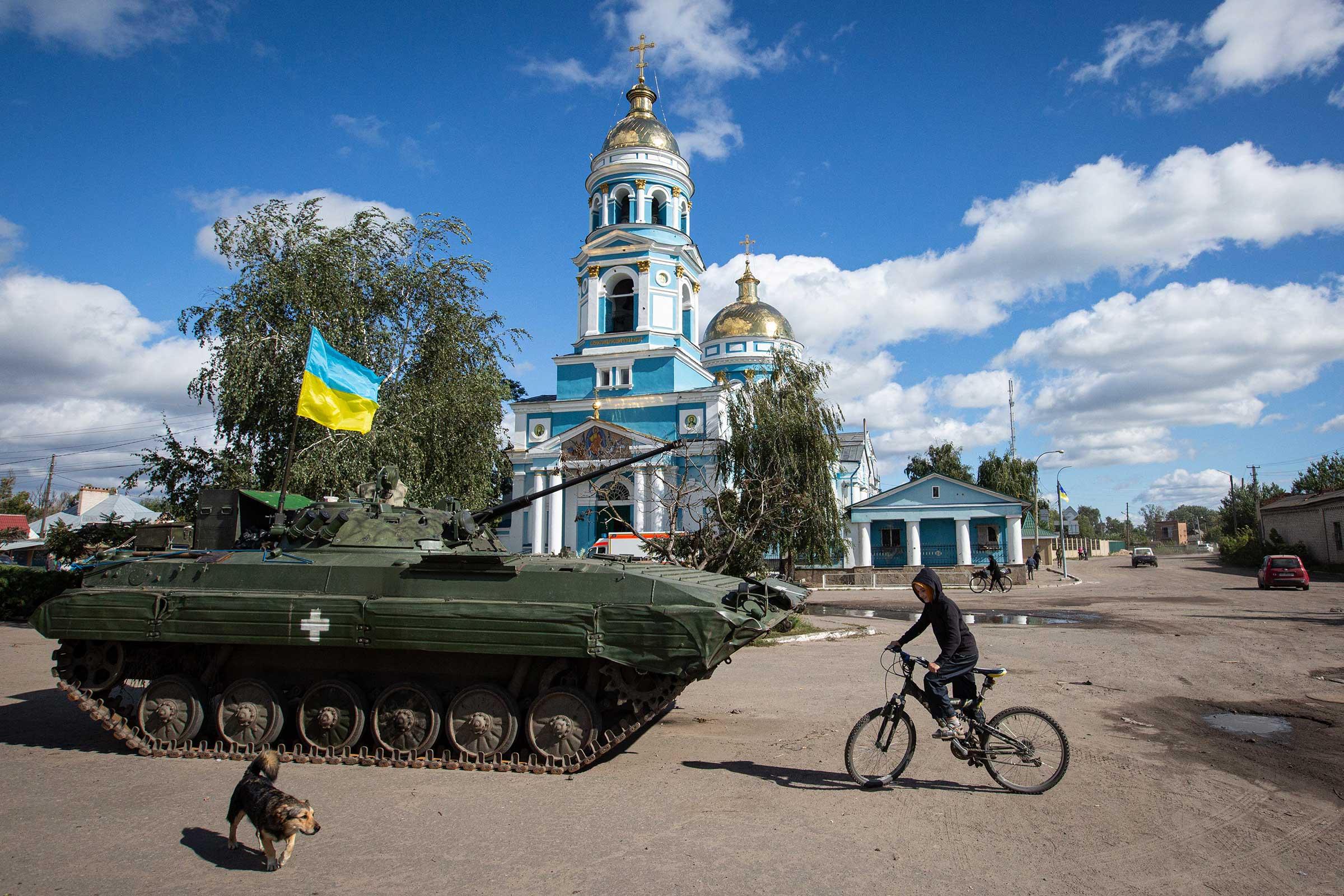
Ukrainian officials are careful to spread the credit for the military successes so far. “It’s not a story of one star, but a constellation of our military elite,” Reznikov says, naming a long list of celebrated officers from the armed forces—the infantry, navy, air force, medical corps and others.
There are rumors of tensions between Zelensky and his top military commander, though the President and his aides have dismissed them. “The so-called conflict with Zaluzhny was invented by our opposition from start to finish,” says Oleksiy Arestovych, a Zelensky aide and veteran of Ukraine’s military intelligence service. “On the one hand, it’s obviously made up. On the other, it has a painful effect, because stirring up conflict between the military commander and the commander in chief is a catastrophe.”
Hardened by war, Ukrainian leaders know the recent successes have only bought time. “Russia has staked everything on this war,” says Danilov, the head of Ukraine’s National Security and Defense Council. “Putin cannot lose. The stakes are too high.”
Ukraine’s operations in the south have moved slowly. As winter approaches, Kyiv must take care not to overextend its forces. And there are forces at play outside Ukraine’s control. The looming energy crisis could sap Western military support, with Russia already cutting its gas supplies to Europe from 40% to 9%.
For his part, Zaluzhny is girding for a long and bloody slog. “Knowing what I know firsthand about the Russians, our victory will not be final,” he told TIME. “Our victory will be an opportunity to take a breath and prepare for the next war.” —With reporting by Leslie Dickstein and Simmone Shah
More Must-Reads from TIME
- Cybersecurity Experts Are Sounding the Alarm on DOGE
- Meet the 2025 Women of the Year
- The Harsh Truth About Disability Inclusion
- Why Do More Young Adults Have Cancer?
- Colman Domingo Leads With Radical Love
- How to Get Better at Doing Things Alone
- Michelle Zauner Stares Down the Darkness
Write to Vera Bergengruen at vera.bergengruen@time.com
